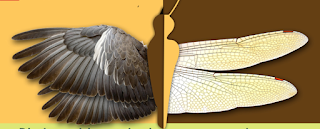Analogous and Homologous Traits
The human arm and the wing of a bird have homologous
traits. They both share the same types
of bones because they both have evolved from a common ancestor. Although they
have the same types of bones they are used in different ways. From the outside
they look very different. The human arm is covered in skin and the bird wing is
covered in feathers. From the inside they have very similar bones. These bones
include the humerus, radius, ulna, carpals, metacarpals, and phalanges. Although these two species have the same
types of bones, the human arm and the wing of a bird have been modified to conduct
different functions. Humans use their
arms to reach and pick up objects. Birds have evolved into wings that help them
to fly. It is believed that humans and birds evolved from a common ancestor.
The common ancestor an ancient reptilian creature appeared to live 320 million
years ago.
Bird and insect wings have analogous traits. They serve the
same functions but they have different evolutionary origins. The bird wing is
covered in feathers and the insect wing does not have feathers. The wings of a
bird and of an insect both perform the same function. They both use their wings
for flying. However, birds and insects have evolved separately. Birds have evolved from ancient dinosaurs. Although
birds and insects exhibit similar features, they are not related in any manner.


My kingdom for a paragraph break! :-) Seriously, though, these are blogs but they should still be treated as papers, complete with correct formatting and breaking topics/prompts into separate paragraphs. It is very difficult to parse out where you address the different questions. Don't make it hard for me to grade your work.
ReplyDeleteYou kind of jump right into the discussion of the trait comparisons, but the opening section in both the homologous and analogous areas asked for a description of your species, not just identification of the species or the traits. This would help your reader understand the environment and behavior of the species to better understand why their traits evolved the way they did. Needed to be expanded.
Homology: You offer a good description on the differences in function and environment inthe section section, but go a bit superficial with respect to differences in structure, yes, they look different on the outside, but how do the bones themselves differ to produce this difference in function. It is the skeletal system itself that is the shared homologous trait, not the wing or the arm. It serves at the basis for the structure and needs to be addressed. They have the same bones, but they bones themselves are structurally very different, in length, breadth, shape and density, and all of this should have been part of the discussion here to better understand these traits.
"It is believed that humans and birds evolved from a common ancestor."
Belief has nothing to do with this. More accurate to say that "evidence supports a common ancestor".
"The common ancestor an ancient reptilian creature appeared to live 320 million years ago. "
Okay.. but how do we use this to confirm that the skeletal system of these traits are homologous? Humans are mammals, who arose from reptiles. Birds also arose from reptiles, so we know that the common ancestor would be an archaic reptile. We also know from the fossil record that early reptiles possessed that generalized reptilian limb structure (complete with the bones you identify) and passed that onto these two descendant species, with changes concurring over time due to differences in the environment (flight vs. manipulative). That is what we need to know to confirm common genetic origin and confirm homology.
Google limited my response, so I will continue it here:
Delete______________________________________________________
Analogy: "The wings of a bird and of an insect both perform the same function. They both use their wings for flying."
The focus of this section was to describe the similarities in function/structure and the environmental pressures that produced those similarities. We aren't surprised by the differences here because these traits are not genetically related. It is the similarities that are interesting and need to be explained.
"Birds have evolved from ancient dinosaurs. Although birds and insects exhibit similar features, they are not related in any manner."
This section on ancestry asks from perspective of a common ancestor as we are trying to produce the evidence that these traits are indeed analogous, due to their lack of genetic relatedness. Note that while the *traits* are not genetically related, the organisms ARE. As explained in the guidelines, all organisms share a common ancestor if you go back far enough. So what information do we need to know to confirm that these traits are analogous?
Now I will admit that it is difficult to guess at what the common ancestor of the bird and butterfly looked like some 100's of millions of years ago... it may have possessed wings or it may not have, but fortunately, we don't need to know that to confirm that these traits are analogous. While it is possible that the butterfly inherited its wings from that common ancestor, what about the bird? We know quite a bit about bird and bird-wing evolution. Birds evolved wings as they split from reptiles, and this occurred long, long after the split with that common ancestor with the butterfly. This means bird wing evolution occurred independently from that common ancestor with the butterfly. That is sufficient to confirm that these are not the product of common descent and are indeed analogous.
Good images.